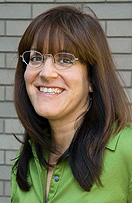Close Up
Exploring women’s role in architecture
-
 Print
Print -
 Comments
Comments
-

“Discussions about diversity in architecture have been growing and developing, but I think there’s a long way to go. I want to see how I can push those further.”
“Professor builds case for Barbie as architect,” read the headline in the Sunday Buffalo News in early February. The story detailed architecture faculty member Despina Stratigakos’ campaign on behalf of Architect Barbie in a contest to determine the doll’s next job.
The assistant professor’s lobbying—which included curating an exhibition of prototypes at the University of Michigan in 2007—might seem frivolous at first.
But sit down to talk with Stratigakos and the gravity of her undertaking becomes clear. Though Barbie regularly draws feminist resentment, the toy is an icon, Stratigakos says. She believes an Architect Barbie would encourage girls to think of themselves as architect material. And in a field where men outnumber women by as much as 4 to 1, according to some reports, that matters.
The initiative ties in with Stratigakos’s research, which revolves around the role of women in architecture.
Her most recent book, “A Women’s Berlin,” explores the German capital at the turn of the 20th century, a time when more and more women were defying convention by pursuing educations and launching careers instead of relying on husbands for their income and identity.
Berlin, as a physical space, no longer met the expectations of these trailblazers. They were modern; the infrastructure was old. As Stratigakos sees it, “they broke the mold, and the problem was there was no architecture to go along with their lives.” Many landlords still refused, for instance, to rent to bachelorettes.
So women set about envisioning and creating a metropolis of their own. They banded together to build apartment complexes for female workers and a dormitory for female university students. They created their own schools, workspaces and places of leisure. Many construction projects united female patrons with female architects and designers. A 1912 exposition in Berlin that Stratigakos equates to a “women’s world fair” drew half a million visitors.
The feminist remapping of Berlin changed not only the look of the city, but the way people thought and felt about it. Prior to this reinvention, women had perceived the world outside the home as dangerous, with villains such as Jack the Ripper cruising the streets. Going out alone was taboo.
Progressive women, through their architectural ventures, “were completely rewriting those narratives about the city,” Stratigakos says. “They repositioned themselves as subjects instead of as objects, as people who actually control this space. It’s an incredible shift to make, and very brave.”
The reinvention of Berlin was both a fascinating and frustrating topic to investigate. Archives Stratigakos reviewed had not collected the documents she needed to complete her work. Those papers and materials still resided with families of female designers.
“I had the chance to meet the grandchildren of these women, hear the stories about their incredible grandmothers,” Stratigakos says. “It really is detective work, piecing the clues together and trying to figure out where your next clues will be. And in the end, it’s much more fun. I met an incredible diversity of people in Germany through this scholarship—everything from royalty to tradespeople. One of my interviews was with a prince in a castle. His aunt had been one of the first female architects. There was a moat and I couldn’t find the drawbridge,” she remembers.
In 2009, the German Studies Association honored “A Women’s Berlin” as the best book of the preceding two years in history and the social sciences. The endeavors of the women of the late 19th and early 20th century continue to hold relevance today. They demonstrate that diversity in the planning occupations is crucial, Stratigakos says. Cities and spaces of all kinds rise, after all, in the image of their makers.
Stratigakos’s interest in gender in architecture grew from a radio interview she heard about 20 years ago in her native Montréal. The guest speaker was a former student of the famous German Bauhaus design school, and “he started talking about all the great parties they had at the Bauhaus and his dancing partners and all of these women students,” Stratigakos recalls. “And I remember thinking, ‘What is he talking about? What women at the Bauhaus?’ I discovered that half of the students at the Bauhaus had been women, a whole side of the school’s history that at that point wasn’t known.”
Her doctoral dissertation at Bryn Mawr College discussed the entry of women into architecture in Germany, and her newest venture, a book on Gerdy Troost, one of the most powerful architects in Adolf Hitler’s Third Reich, is a continuation of that theme.
Closer to home, Stratigakos is partnering with the Buffalo Public Schools and local architecture firms to develop initiatives to increase diversity in the student body of the School of Architecture and Planning, particularly at the undergraduate level.
She notes that architecture programs in the U.S. have struggled to attract students of color and that the profession fails to retain women. While female students excel in such programs, they often do not continue into practice.
Computer Engineer Barbie logged the highest vote count in toy manufacturer Mattel’s most recent “I Can Be” competition. But that doesn’t mean Stratigakos is giving up her calling to explore the role of women in architecture and cultivate their success in the field.
Beyond her own scholarship, Stratigakos encourages young architects to think, too, about gender issues. In 2006, in a seminar she taught at Harvard University, where she worked before joining UB in 2007, young architects teamed up with Amnesty International to organize a symposium on how shelter—or a lack of it—affects the lives of domestic violence victims.
“Discussions about diversity in architecture have been growing and developing, but I think there’s a long way to go,” Stratigakos says. “I want to see how I can push those further.”

Reader Comments